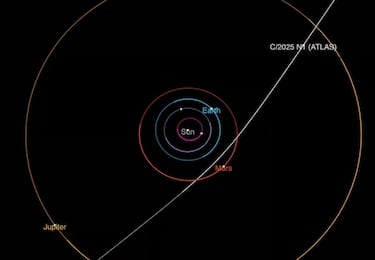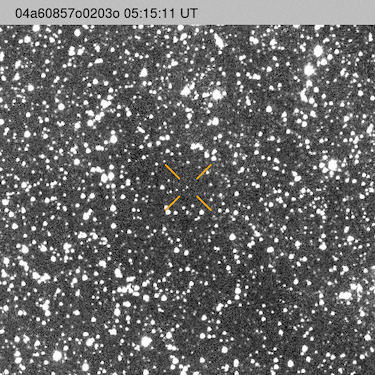Michael Kueppers, ESA astrophysicist: “It’s almost impossible to know where 3I/ATLAS comes from”
The expert spoke to us at AS about the nature of the third interstellar object detected by humanity.

Look! Up in the sky! Is it a bird? Is it a plane? No… it’s comet 3I/ATLAS, the unexpected protagonist of public debate on Earth, even though it’s roughly 190 million miles away. The comet, discovered this summer, doesn’t belong to our solar system because its speed doesn’t match that of objects orbiting the Sun. Michael Küppers, an astrophysicist with the European Space Agency (ESA), speaks with this outlet to clarify the comet’s nature and explain why space agencies have launched a special observation program to track 3I/ATLAS.
An interstellar visitor
Question: What is 3I/ATLAS?
Answer: It’s a comet that comes from another stellar system, from another star. It’s the third one we’ve ever discovered. The first, 1I/ʻOumuamua, resembled an asteroid more than a comet, but the second, 2I/Borisov, was more similar to ATLAS.
Q: What’s the difference between a comet and an asteroid?
A: A comet, like ATLAS, formed outside our system and follows elliptical or sometimes parabolic trajectories. It’s a mix of ice and dust that, when nearing the Sun, causes the ice to evaporate and form a tail that always points away from the Sun due to solar wind. An asteroid, on the other hand, is inert – most of them are found in the asteroid belt between Mars and Jupiter, in roughly circular orbits.

A unique celestial case
Q: What makes ATLAS different from the other two interstellar objects?
A: This one is an active comet, unlike ʻOumuamua, from which we never detected any activity. Compared to Borisov, it’s similar but comes closer to the Sun, is more active, and therefore easier to study. However, it travels at greater speed and with an eccentricity of 6, meaning it passes almost in a straight line. That suggests it has been in space for a very long time – billions of years, about the age of the solar system. Comets like ATLAS give us a rare glimpse into the conditions of other star systems.
Q: When it reached perihelion, it accelerated oddly. How do you explain that?
A: It’s due to the reaction force of gas and dust expelled from the comet. Solar heat sublimates the ice in its nucleus – the ice turns directly from solid to gas – and that gas escapes through cracks or jets on the surface. Each jet pushes the nucleus in the opposite direction, following Newton’s principle of action and reaction.
Why so much excitement?
Q: Why has there been so much interest around this comet?
A: ʻOumuamua sparked massive interest because it was the first. The second one drew a little less attention, maybe because it coincided with the pandemic. But this is a unique event – something we rarely get to see – so there’s a lot of scientific and public fascination.
Q: Can it only be studied through observation?
A: Yes. Observation, usually from Earth, is our only option. Since ATLAS passes near Earth at perihelion, we can also view it from satellites like ESA’s JUICE, currently en route to Jupiter and well positioned to observe the comet.
A special global campaign
Q: A specific observation campaign was launched just for this comet. Is that usual?
A: Yes. There have been several campaigns by the International Asteroid Warning Network (IAWN) – a UN organization led by NASA – aimed at planetary defense from asteroids that might one day collide with Earth. These campaigns focus on tracking objects and predicting their trajectories.
Q: But space agencies knew ATLAS wasn’t a threat. Why the campaign, then?
A: We know it’s not dangerous, and no planetary defense protocol has been activated, unlike with IR4, which once had a 2–3% chance of hitting Earth. With ATLAS, the goal is to practice the scenario – to see how quickly and accurately we can determine an object’s trajectory, just in case a future comet poses a real threat.

What scientists hope to learn
Q: What are you expecting from the observation campaign?
A: As much data as possible on its composition, size, and maybe its physical characteristics. Studying ATLAS is like holding a fragment of another system’s history – just as planets in our solar system formed from small bodies like asteroids and comets, those that survived tell us how everything began. With ATLAS, we can study the same process from a different system.
Q: Will we get higher-resolution images?
A: To some extent, yes. As it passes perihelion, the resolution won’t be enough to clearly resolve the nucleus, but we’ll gather more data both during and after the observation campaign.
Near-Earth objects and public concern
Q: Has science ever felt alarm over an object’s proximity to Earth?
A: Occasionally we find asteroids with some chance of collision, but we’ve never been truly worried. For example, IR4 last year had only about a 2% probability. Twenty years ago, the asteroid Apophis was discovered – it will pass within 30,000 kilometers of Earth in 2029. At first, we thought it might collide, but after a few days earlier observations proved it wouldn’t. There’s never been any real panic.
On life and “alien technology”
Q: You once said that if we ever found evidence of extraterrestrial life, it wouldn’t be on a comet.
A: That’s right. Life can’t survive on a comet. Maybe one day we’ll find microscopic life elsewhere, or intelligent life around another star, but I can’t imagine life reaching Earth via a comet.
Q: Why do some scientists claim 3I/ATLAS might be alien technology?
A: It’s hard to say – those ideas seem made up. Based on observations, it’s a normal comet, even if it has some slightly different components, which makes sense since it comes from another system. I don’t see any evidence for such theories. Probably it’s just attention-seeking.
The mystery of its origins
Q: Is it normal for a comet to contain so much nickel, like ATLAS?
A: Generally speaking, its composition isn’t so different from comets in our solar system, but it does stand out for its high nickel content. That likely reflects the materials present in the system where it formed.
Q: Do we know where the comet comes from?
A: We can estimate based on its age that it comes from a particular region of the Milky Way, but not exactly where. It’s been traveling for so long that pinpointing its origin is nearly impossible unless it came from a nearby star.
Future missions
Q: What other programs are designed to study comets?
A: ESA plans to launch the Comet Interceptor mission in 2028 or 2029. It will be the first time we observe a comet – either from our solar system or beyond – up close. The comet will be discovered first, then the spacecraft, stationed at the L2 Lagrange point in a stable orbit, will depart to intercept it once it’s detected.
Related stories
Get your game on! Whether you’re into NFL touchdowns, NBA buzzer-beaters, world-class soccer goals, or MLB home runs, our app has it all.
Dive into live coverage, expert insights, breaking news, exclusive videos, and more – plus, stay updated on the latest in current affairs and entertainment. Download now for all-access coverage, right at your fingertips – anytime, anywhere.
Complete your personal details to comment